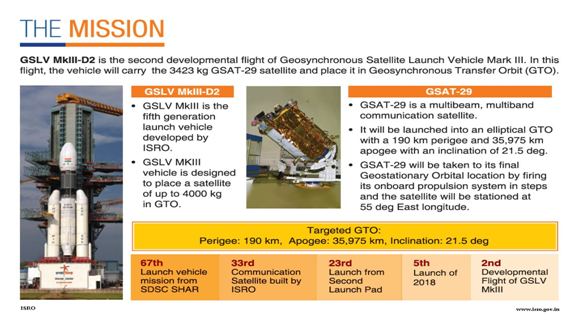

GSAT-29 communication satellite was successfully launched by the second developmental flight of Indian Space Research Organisation (ISRO)’s Geosynchronous Satellite Launch Vehicle Mark III (GSLV MkIII-D2).
Context
- GSAT-29 communication satellite was successfully launched by the second developmental flight of Indian Space Research Organisation (ISRO)’s Geosynchronous Satellite Launch Vehicle Mark III (GSLV MkIII-D2).
- The launch took place from the Satish Dhawan Space Centre (SDSC) SHAR in Sriharikota. The vehicle injected the satellite into Geosynchronous Transfer Orbit (GTO).
About
- The GSAT-29 with a weight of 3,423 kg is a multiband, multi-beam communication satellite.
- The satellite is designed for a mission life of 10 years and will serve as a test-bed for several new technologies in the future.
- Its Ku-band and Ka-band payloads are configured to cater to the communication requirements of users including those from remote areas especially from Jammu & Kashmir and North-Eastern regions of India.
- In addition, the Q/V-Band communication payload on-board is intended to demonstrate the future high throughput satellite system technologies.
- The on-board Geo High Resolution Camera will carry out high resolution imaging.
- The on-board Optical Communication Payload will demonstrate data transmission at a very high rate through optical communication link. This unique laser based optical communication is being tested for the first time by the ISRO.
GSAT-29 is the 33rd communication satellite of India.
|
GSLV Mk III
|
Significance
- With the launch, the GSAT-29 satellite aims at solving the communication barriers faced by Village Resource Centres (VRCs), which are responsible for providing space-based services to ISRO from rural areas.
- Further, India has achieved significant milestone with its heaviest launcher lifting off the heaviest satellite from the Indian soil.
- The success of GSLV MkIII-D2 marks an important milestone in Indian space programme towards achieving self-reliance in launching heavier satellites. This also marks the completion of the experimental phase of GSLV Mark III.



